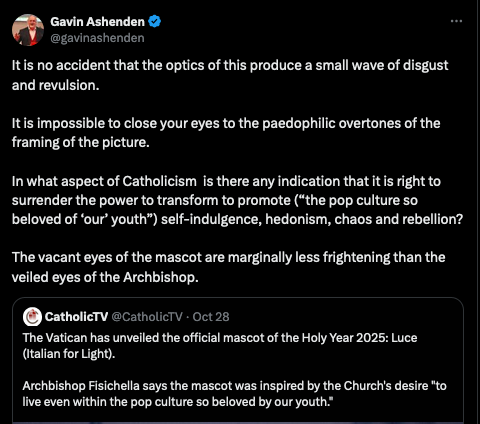Posted on 10/28/2024 1:45:24 PM PDT by ebb tide
We have completed our work as synod delegates and have, with the approval of the Holy Father, published our final document: “For a Synodal Church: Communion, Participation and Mission.” This is the fruit not only of our prayer, dialogue and discernment over these past two years in Rome, but even more importantly, reflective of the broad consultation that began in 2021 with the People of God in every diocese in the world. What are the highlights of this document? As I see it, they are as follows:
This is an important phrase and concept that appears early in the document (No. 28). It means that along with, for example, the concept of the magisterium or the tradition of social justice, it is an essential element of the church. The final document says that synodality—which is defined in a variety of ways in Part 1—is a path that enables the church to be more “participatory and missionary,” and can no longer be considered a curiosity, a practice to be dabbled in or a passing fad. Rather, it is essential to how the church understands itself.
Always oriented toward mission—and therefore not an end to itself—synodality can be seen as “gathering at all levels of the Church for mutual listening, dialogue, and community discernment” (No. 28). This ancient path finds its roots in the Council of Jerusalem and in the “constant ecclesial practice of meeting in synods,” a process that helps us together to “dialogue, discern and decide” (No. 28). For me, this is one of the most important messages of the synod: the fundamental place of synodality in the church.
The final document is firmly grounded in the person of Jesus Christ, something that seemingly every delegate desired. The overarching theme of the document is the Resurrection—the theme of Cardinal-elect Timothy Radcliffe’s retreat for this final session of the synod and the visual backdrop in the Paul VI hall, where we met every day. The Resurrection provides not only the document’s literary structure but also its spiritual foundation. All we do, we do for, through and with the Risen One.
One theme repeated over and over in this document, in regard to almost every facet of the life of the church, is wide participation in decision-making. “[I]t is essential that we promote the broadest participation possible in the discernment process, particularly involving those who are at the margins of the Christian community and society” (No. 82). It would be impossible to read this document and not understand that all people should have a voice in both the decision-making and decision-taking processes, while still recognizing the role of the hierarchy.
It is a recognition, once again, that the Holy Spirit is active and alive in all the People of God—not simply in cardinals, archbishops, bishops and priests. The final document also helpfully outlines procedures for listening and discernment. This extends to all levels of the church, including future synods, which are recommended, as this Synod did for the first time, to include not simply bishops but “other members of the People of God” (No. 136) Likewise, in terms of decision-making, the document also includes a strong call for the People of God to have “a greater voice in choosing bishops” (No. 70). Finally, to this is added the strong call for transparency, accountability and evaluation at all levels of the church, as a way of inviting the faithful to see, judge and understand how their pastors are operating (No. 95).
The call for listening and participation is central to the document, as I have mentioned. And it is bishops and pastors who are most strongly called, over and over, to listen to the voices of the faithful in their dioceses and parishes:
Those in authority are, in several instances, obligated by current law to conduct a consultation before taking a decision. Those with pastoral authority are obliged to listen to those who participate in the consultation and may not act as if the consultation had not taken place. Therefore, those in authority will not depart from the fruits of consultation that produce an agreement without a compelling reason which must be appropriately explained…” (No. 91).
It’s also worth quoting No. 92 at length, which speaks of the authority of the bishop, the episcopal conferences and the bishop of Rome, to make decisions, which is grounded in the magisterium. Nonetheless:
Such an exercise of authority…is not without limits; it may not ignore a direction which emerges through proper discernment within a consultative process, especially if this is done by participatory bodies.
On the parish level as well, the church is encouraged to listen to all—especially to those who feel marginalized—the synod recommends that parishes consider instituting a “ministry of listening and accompaniment.” To my mind, this proposal was truly a fruit of the Holy Spirit and seemed to spring naturally from our long conversations about the church we all love and serve. As the document notes, we didn’t decide if this was to be mandated but recommended that local churches should experiment with this new ministry (No. 78). But all locales do not have to move as fast on this, or on other suggestions, since a synodal style recognizes, “Differences in pace can be valued as an expression of legitimate diversity…” (No. 124).
Throughout both sessions of the Synod, we delegates grappled with how best to ensure that the faithful are able to be heard and can participate in the life of the church, which is centered, in most parts of the world, and for most people, in parish life. And so a variety of consultative bodies in both the Latin and Eastern Catholic Churches are noted, including, for the Latin Church: diocesan synods, presbyteral councils, diocesan pastoral councils, parish pastoral councils and diocesan and pastoral councils for economics affairs (that is, finance councils), are central to participation, accountability and transparency. These are all provided for in canon law, but often exist only “nominally.” Therefore, we write, “We insist that they be made mandatory, as was requested at all stages of the synodal process, and that they can fully play their role, and not just in a purely formal way…” (No. 104).
At the beginning of the synodal process, back in 2021, there were high hopes among many people that the synod would solve, or even adjudicate on, some controversial issues, including the ordaining of married men to the priesthood, the ordination of women to the diaconate and L.G.B.T.Q. issues. For the most part these issues were handed over to the 10 “study groups” for further discernment. This made sense: The prospect of 350 delegates coming to a conclusion on some of these complicated topics in a few weeks was untenable. Also the study groups made it possible for us to concentrate on the topics above. Nonetheless, many of these topics were in the background of our discussions. It’s hard to talk about women’s roles in the church without the topic of ordination to the diaconate arising. And the work of Study Group 5 (on the role of women) has been much in the news, with Cardinal Victor Manuel Fernández initially not attending a meeting for synod delegates and then, on Thursday, speaking for 90 minutes on the topic before roughly 100 delegates. For our part, we said, in a much larger section on women, “There is no reason or impediment that should prevent women from carrying out leadership roles in the Church: what comes from the Holy Spirit cannot be stopped. Additionally, the question of women's access to diaconal ministry remains open. This discernment needs to continue” (No. 60).
The place of women overall was a central theme to the document, as it was an almost constant theme in our discussions over the last two years. (And it was not “controversial.”) Paragraph No. 60 begins with a clear statement (which many delegates from the developing world championed) on the “equal dignity” of women. We note their participation in all levels of the church, including “in positions of responsibility in Church institutions, in diocesan curias and the Roman Curia,” and we ask for the “full implementation of all the opportunities already provided for in Canon Law” for women, particularly those roles that have been “under-explored.” There is also a call for “a significant presence of women” in the education and formation of priests and deacons (No. 148).
As for L.G.B.T.Q. issues, there was considerably greater openness to the topic this year, and ease of discussion overall, for several reasons. Mainly, because the topic was assigned to a study group, there was less need for delegates to, in a sense, debate the issues. But overall, I feel the attitude has shifted markedly among most delegates—and for the better. In the document, the term “L.G.B.T.Q.” is not used—not surprising, since it is still anathema for some delegates—but we ask the church to listen to those who “experience the pain of feeling excluded or judged, because of their marital situation, identity or sexuality” (50). Still, it is quite a feat that 350 delegates from around the world could agree on this kind of language. (The inclusion of the term “identity” was a pleasant surprise for me.) The final document is sure to delight some, disappoint others and perhaps even anger some people. But it is only the first step of a process for our church, as we journey with the Risen Christ “together on the road”—which is, of course, the ancient meaning of synod.
[The final document can be read in Italian here.]
And, hopefully, with the next pope this all goes away.
Some good news for you, oystir.
Thank you for including me. Isn’t inclusion wonderful, ebby?
How could you forget the “+”?
Sorry for offending you. Your type is so sensitive.
Remember the reportage here years ago about the Stang? Yeah. 
A Stang is a witch/warlock’s ceremonial staff. It is always forked, and always has an iron nail driven through it. Ideally it has a human form carved or integrated into it somehow. The Stang signifies several things, the first being a satan himself. Read the quote below from a witchcraft blog:
“Gary describes the Stang as primarily a symbolic tool rather than a working one, and as such it stands in for the Devil himself, holding his power and his dual nature. The Devil and the Stang is often less about strict duality and more about the transgressing of boundaries, The Devil being a spirit I often think of as non-binary and difficult to define in terms of absolutes.”
That’s mild compared to this quote from the same article:
“The witch is bound to no dogma. This makes them a threat to a Christianity established on doctrine. The witch insists everything in creation has its place. The Church insisted on two contrary substances God and The Devil. The witch strives for synthesis.”
Nicholaj De Mattos Frisvold- Craft of The Untamed.
G.W.F. Hegel, please dial “666” on a white courtesy telephone….



It is no accident that the optics of this produce a small wave of disgust and revulsion.
I'd rather not be included in Jorge's Homos march into Hell.


Although the true meaning of Stang is a stick or a rod (and not tied to witchcraft - though witches seem to be stealing the word) I agree with you that the little doll, or whatever it is, is a bit creepy. With that said, the eyes (scallops) are very similar to the trail markers for the Portuguese Camino - St. James Way, which is definitely Christian.
No comments on the rainbow rosary?

Disclaimer: Opinions posted on Free Republic are those of the individual posters and do not necessarily represent the opinion of Free Republic or its management. All materials posted herein are protected by copyright law and the exemption for fair use of copyrighted works.